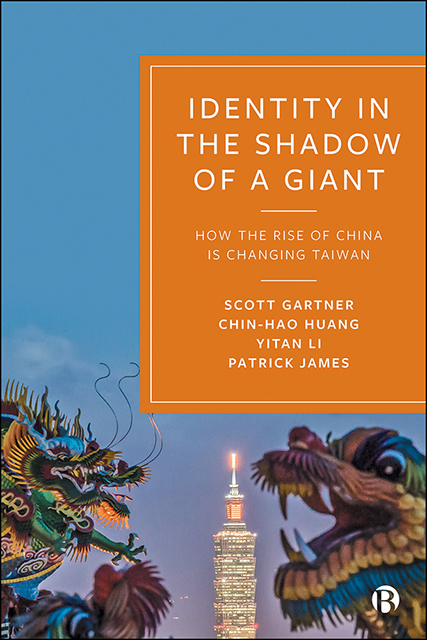Book contents
- Frontmatter
- Dedication
- Contents
- List of Figures and Tables
- About the Authors
- Acknowledgements
- Preface
- 1 Identity in the Shadow of a Giant: How the Rise of China Is Changing Taiwan
- 2 Taiwan in Historical Perspective
- 3 The Problématique of Taiwanese Identity
- 4 Theorizing about Identity, Change in Capabilities and Dyadic Relations: An Approach Based on Analytic Eclecticism and Systemism
- 5 Elite Reflections
- 6 Popular Reflections (Survey I)
- 7 Factors Influencing Identifying Only as Taiwanese: A Layered Empirical Approach (Survey II)
- 8 A New Vision of Taiwanese Identity, the Rise of China, Cross-Strait Relations and the United States in Northeast Asia
- Appendix A Research Interview Questions, September–October 2015
- Appendix B Taiwanese Identity and the Rise of China: Survey Questions, 27 October 2015
- Appendix C Taiwan National Security Survey by Emerson Niou
- References
- Index
8 - A New Vision of Taiwanese Identity, the Rise of China, Cross-Strait Relations and the United States in Northeast Asia
Published online by Cambridge University Press: 15 April 2023
- Frontmatter
- Dedication
- Contents
- List of Figures and Tables
- About the Authors
- Acknowledgements
- Preface
- 1 Identity in the Shadow of a Giant: How the Rise of China Is Changing Taiwan
- 2 Taiwan in Historical Perspective
- 3 The Problématique of Taiwanese Identity
- 4 Theorizing about Identity, Change in Capabilities and Dyadic Relations: An Approach Based on Analytic Eclecticism and Systemism
- 5 Elite Reflections
- 6 Popular Reflections (Survey I)
- 7 Factors Influencing Identifying Only as Taiwanese: A Layered Empirical Approach (Survey II)
- 8 A New Vision of Taiwanese Identity, the Rise of China, Cross-Strait Relations and the United States in Northeast Asia
- Appendix A Research Interview Questions, September–October 2015
- Appendix B Taiwanese Identity and the Rise of China: Survey Questions, 27 October 2015
- Appendix C Taiwan National Security Survey by Emerson Niou
- References
- Index
Summary
Who is it that can tell me who I am?
(King Lear in William Shakespeare, King Lear)Who am I? I am myself and I’m looking for myself.
I’m thinking of myself, looking at myself and getting to know myself.
I’m questioning myself, hating myself but also loving myself.
(Wu Hsing-Kuo, ‘A Taiwanese Actor's Personal Response to King Lear’)Overview
This study has focused on Taiwanese identity, the ascent of China, cross-Strait relations and the role of the US in Northeast Asia. An ensemble of methods has been applied in order to learn more about how these items theoretically and empirically impact upon each other. Our method thus draws on the broad-brush approach often employed to think about confusing and conflicted identities and their fundamental ideational questions, such as those posed by King Lear and Wu Hsing-Kuo. The significant difference in time and location for the preceding questions reinforces the point that issues of identity are global and immanent.
What, then, can be said about Taiwanese identity in connection with the ascent of China, cross-Strait relations and US activity in Northeast Asia? A look back at preceding chapters will set the stage for the tasks that remain to be carried out. All of this works towards a sense of where identity stands among the ideal points identified in Table 1.1, which include primarily ideology-or interest-based, along with gradations in between.
We began in Chapter 2 with a historical overview of Taiwan from early times, with emphasis upon the period after the KMT migration in the late 1940s and especially the years in the new millennium. This material created a context for research on our basic question about identity, while also providing a basic background to those who are specialists in neither Taiwan nor Northeast Asia.
Chapter 3 reviewed academic literature on the evolving Taiwanese identity and factors seen shaping its evolution to obtain a baseline model for elaboration through further research. This chapter demonstrates that there is a long, historical dynamic driving Taiwanese identity. Most critically, however, recent and dramatic improvements in China, especially economically, have created disequilibrium in the Taiwanese ideational process, requiring new efforts to capture these shifting systems and to reconcile them with past dynamics.
- Type
- Chapter
- Information
- Identity in the Shadow of a GiantHow the Rise of China is Changing Taiwan, pp. 181 - 212Publisher: Bristol University PressPrint publication year: 2021



